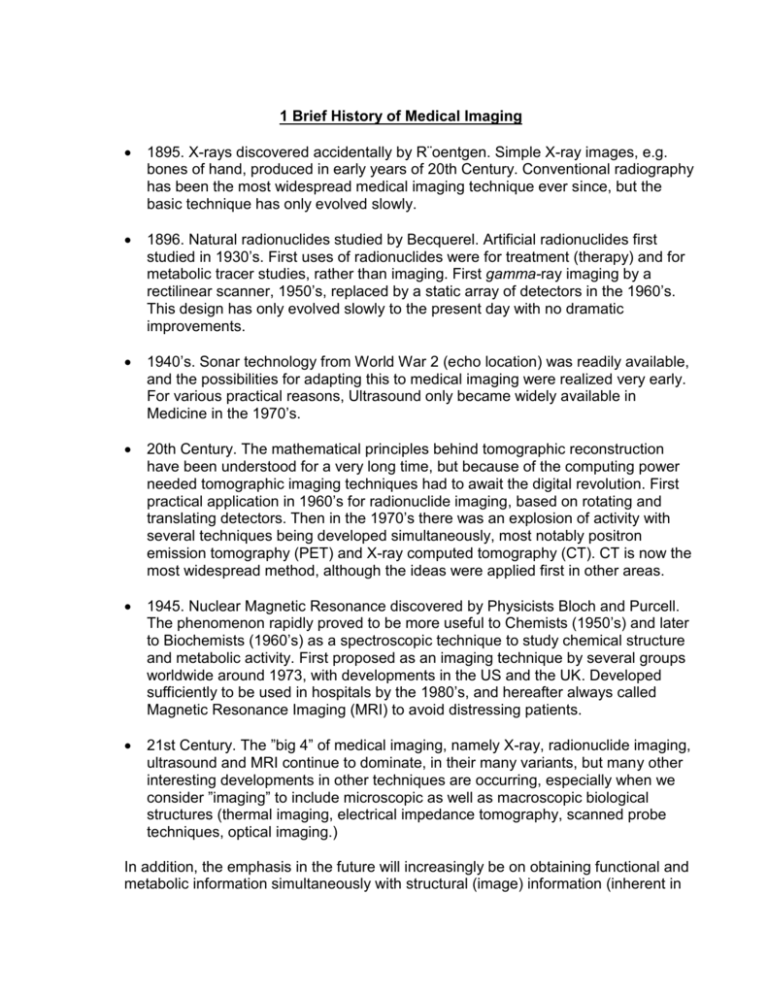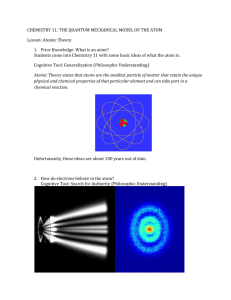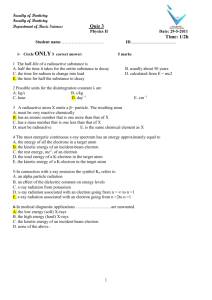1 Brief History of Medical Imaging
advertisement

1 Brief History of Medical Imaging 1895. X-rays discovered accidentally by R¨oentgen. Simple X-ray images, e.g. bones of hand, produced in early years of 20th Century. Conventional radiography has been the most widespread medical imaging technique ever since, but the basic technique has only evolved slowly. 1896. Natural radionuclides studied by Becquerel. Artificial radionuclides first studied in 1930’s. First uses of radionuclides were for treatment (therapy) and for metabolic tracer studies, rather than imaging. First gamma-ray imaging by a rectilinear scanner, 1950’s, replaced by a static array of detectors in the 1960’s. This design has only evolved slowly to the present day with no dramatic improvements. 1940’s. Sonar technology from World War 2 (echo location) was readily available, and the possibilities for adapting this to medical imaging were realized very early. For various practical reasons, Ultrasound only became widely available in Medicine in the 1970’s. 20th Century. The mathematical principles behind tomographic reconstruction have been understood for a very long time, but because of the computing power needed tomographic imaging techniques had to await the digital revolution. First practical application in 1960’s for radionuclide imaging, based on rotating and translating detectors. Then in the 1970’s there was an explosion of activity with several techniques being developed simultaneously, most notably positron emission tomography (PET) and X-ray computed tomography (CT). CT is now the most widespread method, although the ideas were applied first in other areas. 1945. Nuclear Magnetic Resonance discovered by Physicists Bloch and Purcell. The phenomenon rapidly proved to be more useful to Chemists (1950’s) and later to Biochemists (1960’s) as a spectroscopic technique to study chemical structure and metabolic activity. First proposed as an imaging technique by several groups worldwide around 1973, with developments in the US and the UK. Developed sufficiently to be used in hospitals by the 1980’s, and hereafter always called Magnetic Resonance Imaging (MRI) to avoid distressing patients. 21st Century. The ”big 4” of medical imaging, namely X-ray, radionuclide imaging, ultrasound and MRI continue to dominate, in their many variants, but many other interesting developments in other techniques are occurring, especially when we consider ”imaging” to include microscopic as well as macroscopic biological structures (thermal imaging, electrical impedance tomography, scanned probe techniques, optical imaging.) In addition, the emphasis in the future will increasingly be on obtaining functional and metabolic information simultaneously with structural (image) information (inherent in PET and now evolving in functional MRI especially at higher fields). This can already be done to some extent with radioactive tracers (e.g. PET) and magnetic resonance spectroscopy. 2 Introduction First of all we examine EM spectrum from DC to cosmic rays, to find a region to do suitable imaging of tissue. To be useful for imaging EM radiation must have a wavelength small compared to the resolution desired (< 10 mm) and must be reasonably attenuated by body tissue. Too much attenuation results in a low signal to noise (S/N) ratio. Too little attenuation reduces the selectivity or contrast for different structures and tissues. A transmission curve for EM radiation through soft tissue is shown in Fig 1. In the long wavelength region at the left, we have excessive attenuation at all but very long wavelengths where resolution would be extremely poor. In the intermediate regions of the spectrum corresponding to the infrared, optical, and ultraviolet regions, we have excessive attenuation due to both absorption and scatter which limits this range to very thin sections. Hence light transmission is mostly measured on tissue sections removed from the patient and fixed to glass slides, skin layer imaging and for imaging transparent tissue like eye layers. Although absorption is suitable at low frequencies the wavelength is too large for adequate resolution. Between 0.5 and 10-2 °A, (°A = 10-10 m), corresponding to photon energies of about 25 KeV to 1:0 MeV, the attenuation is at reasonable levels with a wavelength far shorter than the resolution of interest. This is desirable since it ensures that diffraction will not in any way distort the imaging system and the rays will travel in straight lines. This is the most widely used region and represents diagnostic x-ray spectrum. At even shorter wavelengths, with energy per photon hν getting increasingly higher, the attenuation becomes smaller until the body becomes relatively transparent and it ceases to be a useful measurement. As well, at these shorter wavelengths, the total energy consists of relatively few quanta, resulting in poor counting statistics and a noisy image. Ultrasonic waves are acoustic rather than EM waves. Although they are relatively low in frequency (1-3 MHz) their velocity is low (1500 m/s) so that the wavelength is small and gives good resolution. Their wavelength is still much greater than that of light, x-rays and gamma rays so that they are more prone to diffraction and scattering. Thus they are unsuitable for transmission imaging but images can be derived from reflected waves. Other differences between ultrasound and x and gamma rays are that ultrasound can be focused by electronic means whereas x-rays and gamma rays cannot. It appears that ultrasonic radiation is far less harmful than x-rays and gamma rays in the doses used for imaging. Ultrasound will be reflected from tissue interfaces that are completely transparent to x and gamma rays, so some soft tissues can only be imaged by ultrasound. Images of the human body are derived from the interaction of energy with human tissue. The energy can be in the form of radiation, magnetic or electric fields, or acoustic energy. The energy usually interacts at the molecular or atomic levels, so a clear understanding of the structure of the atom is necessary. In addition to understanding the physics of the atom, learning imaging jargon is also necessary. For example: Tomography: a cross-sectional image formed from a set of projection images. The Greek word tomo means cut. CT: Computed (or Computerized) Tomography MR, or MRI: Magnetic Resonance Imaging. This was first called nuclear magnetic resonance (NMR), but the mention of anything nuclear scared patients, so the N was dropped. PET: Positron Emission Tomography. Understanding this phenomenon requires acceptance of the theory that there is antimatter in the universe, and when antimatter meets matter, then both kinds of matter are annihilated, and pure energy is formed. SPECT: Single Photon Emission Tomography Ultrasound: Sonar in the body OCT: Optical Coherent Tomography the use of infrared light to image (particularity) the walls of an artery. A modality is a method for acquiring an image. MR, CT, etc. are all imaging modalities. Modalities are often categorized based on the amount of energy applied to the body. For example, the x-ray modality produces energy that is sufficient to ionize atoms (i.e., eject an electron from an orbit of an atom, thereby creating a positively charged ion that damages human tissue). The modalities that cause ionizing radiation are x-rays, CT, SPECT, and PET. Non-ionizing modalities include MR and ultrasound. 3 X-ray Imaging 3.1 Historical Overview IN 1895, Wilhelm R¨ontgen (sometimes spelled as Roentgen) discovered a ”new kind of ray” that penetrated matter. He named them x-strahlen ”x-ray” (”x” for unknown). R¨ontgen was looking for the ”invisible high-frequency rays” that Helmholtz had predicted the Maxwell theory of electromagnetic radiation. R¨ontgen developed the first x-ray pictures on photographic plates, and one of the first materials tested was human tissue. The most famous picture was an image of his wife’s hand with ring on her finger. In 1901 R¨ontgen received the Nobel Prize for Physics, which was the first Nobel Prize in physics ever awarded. Unfortunately, R¨ontgen, his wife, and his laboratory workers all died prematurely of cancer. The first medical use of the x-ray was in 1896 by Drs. Ratcliffe and Hall-Edwards, in which they showed the location of a small need in a woman’s hand. Dr. J. Clayton then performed the first x-ray guided surgery nine days later. 3.2 X-ray Physics An x-ray is an electromagnetic (EM) radiation similar to light, radio waves. The relationship between energy and frequency for EM field is given by the Planck’s relationship E = hf where E is energy in Kilo electron volts (KeV, 1keV = 1.6 x 10-19 joules), h is Planck’s constant 4.13 x 10-18 KeC s or 6.63 x 10-34 Js), and f is the frequency (Hz). At least in a vacuum, all EM waves propagate at the same speed, which is known as the speed of light (c = 3.0 x108 m/s). The relationship is given by c =λf The quantum mechanical interpretation of x-rays is that of particles with velocity ν, mass m and a momentum p and using Einstein’s famous relationship E = mc2 we have that p = mν = mc =E/c=h/λ These x-ray particles are called photons, and these photons are delivered in packets called quanta. If the particle energy is greater than about 2-3 eV, then the photons are capable of ionizing atoms (for example x-ray, SPECT and PET). Diagnostic radiation is typically in the wavelength range of 100 nm to about 0.01 nm or from 12 eV to 125KeV. An electron volt is the energy required to move a quantum of charge through 1 volt of potential. A quantum of charge is 1.60x10-19 coulombs, or the charge of one single electron. To break bond, one requires energies in the order of 2-10 eV, which can be delivered by EM waves in the ultraviolet region or above. Ultraviolet light breaks chemical bonds in tissue (i.e. ionizes tissue), thus it can be a danger to health. If the broken chemical bond breaks are located on the DNA molecule and in just the right place, skin cancer results. The EM energies below the ultraviolet level cannot break chemical bonds, or produce ions. The most dangerous event from these low-energy photons is tissue heating. For instance, infrared light can heat objects by making them vibrate. Microwave oven is the kitchen cause water molecules to tumble, which excitement in turn cause the temperature of the food to increase. 3.3 Brief Review of the Structure of the Atom The interaction of EM waves or particles with the human tissue depends quite heavily on the structure of the atom. Here we outline key atomic concepts relevant to contrast in imaging systems. Three basic particles of an atom are electron, proton, and neutron. There are of course many more smaller subparticles that hold everything together but these are not do affect our understanding of the basic physics of medical imaging systems and will thus be ignored. The electron is negatively, the proton is positively charged and the neutron is neutral. A nucleus consists of two types of particles collectively known as nucleons, protons and neutrons. Each proton possesses a positive charge of +1:6 x 1019 coulombs, exactly opposite that of an electron and a mass of 1.6734 x 10-27 kg. Neutrons, the second type of nucleon, are uncharged particles with a rest mass of 1.6747x 10-27 kg. The rest mass of the electron is much smaller at 9.11 x 10-31 kg. The number of neutrons in a nucleus is the neutron number N, while the number of protons is the atomic number Z. For example, Hydrogen has only one proton and its atomic number is thus one. The mass number A of the nucleus is the number of nucleons (neutrons and protons) in the nucleus so that A = Z +N. If the nucleus has too few neutrons, then the nucleus will be unstable, and fall apart. If the nucleus is too big, or has too many protons and neutrons, the nucleus will also become unstable. There are no stable isotopes of atoms above lead (Pb208). To be neutral, an atom must have the same number of protons as electrons. If the atom is charged, then it is called an ion. The electron cloud surrounding the nucleus largely determines the volume of space occupied by an atom. The electrons cannot go just anywhere, due to their wave nature, electrons are confined to orbital of specific energies. This notion is called the Bohr named after Niels Bohr. The first few shells of the Bohr atom model are: Each shell has a different energy (frequency), and each orbital within the shell has a unique energy. Wolfgang Pauli (1921) later reformulated the Bohr model in terms of quantum mechanical principles. Pauli observed that an atom can be defined by four quantum numbers; – n is the quantum number, which is an integer and scalar quantity; – l is the angular momentum quantum number, a vector quantity that has integer values ranging from 0 to n -1; – mI is the magnetic quantum number with integral values ranging from -1 to 1; and – ms is the spin magnetic quantum number, which has value -1/2 to 1/2 . This spin is the basis of magnetic resonance imaging. According to the Pauli Exclusion Principle, no two electrons in an atom can have the same set of quantum numbers. Thus only two electrons can have the”same” energy value within the atom. In fact, the model states that two electrons having the”same” energy must have unique energies. State in a different way, each electron must have a unique energy since the same energy within a single orbital must have different spins (one being +1/2 and the other being -1/2 ). For any one atom, there can only be one electron for each unique energy level. The energy that we are interested in is the binding energy of the electron in each energy level. This will tell us how much energy we need to impart to the atom in order to dislodge that electron from the atom. Electron binding energies are high, usually on the order of 1-100 keV. Thus at least EM waves with the frequency (energy) of x-rays are necessary to change the electronic structure of an atom. As an example, is an EM signal with wavelength ¸λ = 1nm ionizing? We need to calculate the energy of the wave. If it exceeds 1-2 keV, the n the wave is considered ionizing, and potentially dangerous to human health. Since x-rays can dislodge electrons and make the atom and ion, x-rays are ionizing radiation. This radiation can change the chemical bonds of important substances such as DNA. Diagnostic x-ray radiation is typically in the range of 100 nm to about 0:01 nm, or from 12 keV to 125 keV. Even higher energies are required to change the nuclear structure of atoms. Gamma rays provide sufficient energies to not only cause ions, but also cause a transformation of the atom from one type to another through a change in the atomic mass and number. Radio frequencies are not energetic enough to interact with the atom at all. Instead, radio frequencies interact with the spin of an electron. This property is used in building MR images. 4 Interaction of x-rays and Matter: Contrast There are several modes of interaction of x-rays with matter. The study of x-ray interaction is important for understanding the development of image contrast in medical images, and in understanding how x-ray detectors work. There are five possible modes of interaction: Coherent (Rayleigh) scattering Photoelectric effect Compton scattering Pair production Types of Radiation Interactions There is a finite probability per unit length that the radiation is absorbed. If not, there is no interaction. The radiation interacts almost continuously giving up a small amount of its energy at each interaction. The reduction in the beam intensity should be a property of the object along the line. dI dx I Where is the linear attenuation coefficient. Integrate along the path for a uniform material of length, x. I I 0 e x In general, ( x, y ) I ( x, y ) I 0 e Consider a sample geometry with only a collimator at the output side: So the buildup factor, B, can contribute to the signal as well as the noise. I I 0 Be x Attenuation Mechanisms (a) Simple Scatter (Rayleigh Scattering) The incident photon energy is much less than the binding energy of the electron in an atom. The photo is scattered without change of energy. (b) Photoelectric effect The photon, E slightly greater than the binding energy of electron, Eb gives up all of its energy to a inner shell electron, thereby ejecting it from the atom. The excited atom retains to the ground state with the emission of characteristic photons. Most of these are of relatively low energy and are absorbed by the material. (c) Compton Scattering The photon energy is much greater than the binding energy, and only of this is given up during the interaction with an outer valence electron ( the binding of valence electrons is relatively weak, hence the “free”). The photon is scattered with reduced energy and the energy of electron is dissipated through ionizations. (d) Pair production A very high energy photon interacts with a nucleus to create an electron/positron pair. The mass of each particle is 9.11x 10-31 kg. So the minimum photon energy is: Both the electron and the positron lose energy via ionization until an annihilation event takes place yielding two photons of 0.51 MeV moving in opposite directions. Attenuation Mechanisms The optimum photon energy is about 30 keV (tube voltage 80-100 kV) where the photoelectric effect dominates. The Z3 dependence leads to good contrast: Z (fat)= 5.9 Z (muscles)= 7.4 Z (bone)= 13.9 Beam energy is important This does not include buildup factor or scattering but does include beam hardening. Also need to consider beam energy even if only photoelectric effect, since absorption rate depends on the energy. Thus, low energy photons deliver no useful information.









